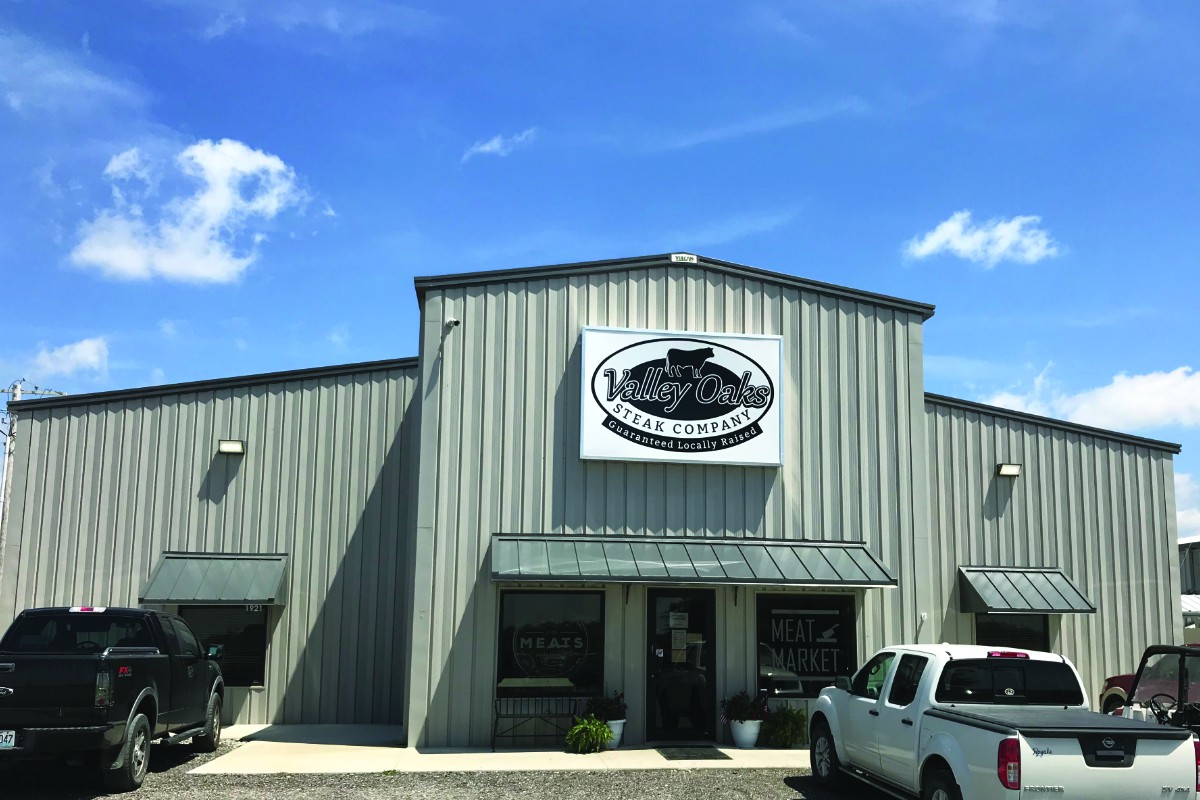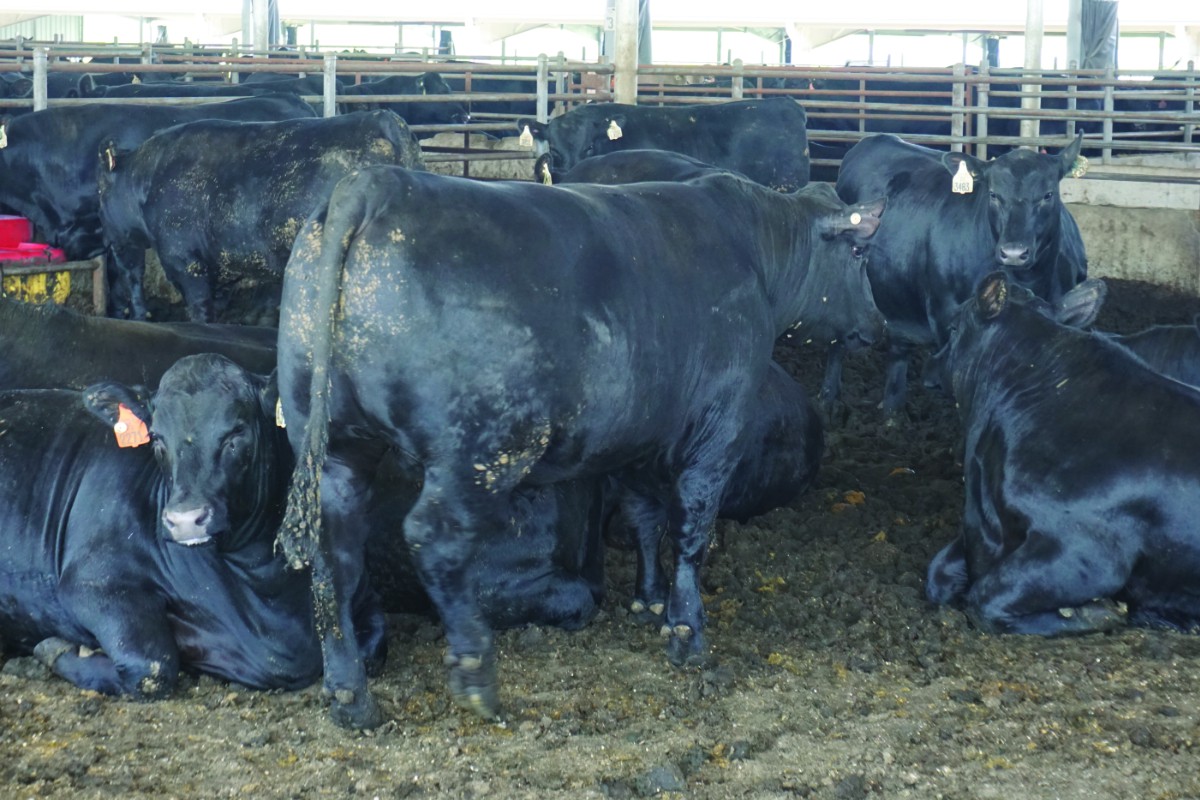Just east of the Kansas City metropolitan area on US Highway 50 sits Valley Oaks Steak Co. The small, vertically integrated processor was built in 2016, employs 70 people and slaughters about 60 head a day in its 50,000-sq.-ft. facility. It was renovated last year, but size and location aren’t what make Valley Oaks especially unique and interesting.
“It’s a completely different type of system than what anybody is really used to seeing being on the same campus with our feedlot,” says Jake Huddleston, operations manager at Valley Oaks. “It really sets a unique set of challenges for us, but then it also sets a really unique set of opportunities the way that we can actually completely control the animal all the way through the system and out to the consumer.”
Working the system
Valley Oaks buys calves from Missouri-based producers and prides itself on keeping everything as close to home as possible. This not only keeps the carbon footprint small by eliminating long transit, but makes it cost effective for both Valley Oaks and the farmers who need to truck their cattle around to processors and feedlot operators.
“We have such a high-quality seed stock of cattle here that are going outside the state that we’re able to capitalize on,” Huddleston says. “These guys aren’t having to pay as much in transportation costs to get them to Grand Island to get him out to Kansas, that really sucks up a lot of the profit.”
Huddleston adds that Valley Oaks still pays more than a major packer due to its size and lets producers make profitable stops on the way to longer destinations. In addition, Valley Oaks puts itself and those producers in the best position to “keep it local,” a trend that is quickly becoming a consumer demand.
Valley Oaks utilizes local suppliers for more than calves, as well. The company sources kiln-dried lumber for the bedding in all its onsite barns.
“We’re sourcing every single wood chip that we can possibly get in the western part of Missouri,” Huddleston says.
The Valley Oaks method also creates a more flavorful beef product. Once harvested, employees move carcasses around the rails by hand. There is no hurry, carcasses age a little on the rail. From harvest to the blast-freezing process and through Huddleston’s sorting, animals usually hang between three to five days before fabrication.
“We’re allowing the animal to go through rigor on the rail and allowing a little bit of evaporation,” Huddleston says. “That creates concentrations of a little bit of flavor. We let it age a little bit. We call it our hybrid process. It’s taking the best of both worlds from the old school, traditional locker method and the new packing methods and kind of finding the best equilibrium between the two.”
As the carcass moves down the rail for fabrication the first stop is the chuck line where the chuck roll and brisket are removed. Next stop is the rib line for both bone in and boneless ribeyes, depending on customer spec for the day. The short rib gets taken off on the rib line as well. The next line is the sirloin for tenderloins, strips and sometimes t-bones. Last is the round line for shank meat and tri tip. One more set of lines for fat and trim come off the mainlines.
Another special attribute of the Valley Oaks system is the slower pace allows for a focus on quality characteristics and a versatility that larger volume producers just can’t manage.
“I mean if there’s anything anybody wants to do, I could do it,” Huddleston says. “That’s really what makes us unique is the ability to change up on the fly and be able to transition throughout the day.”
Huddleston and his team create daily schedules about a week in advance but remain flexible on the line.

Outside the plant
Before cattle become beef, they live and eat and grow, and Valley Oaks makes that time as comfortable as it possibly can for them. They’re not prodded or rushed, sometimes whoever is moving them might clap their hands and say, “hey.” By having the feedlot on campus, cattle simply move from pen to pen and barn to barn on their own, through chutes they are used to.
Just before the knock box there’s a modified squeeze chute like every chute they’ve ever been in.
“They’re used to walking into them, they’ve been walking into them since they were calves,” Huddleston says. “They’re used to walking into a method like that. They think they’re just getting weighed again, or they’re just getting another shot. And yeah, they’re getting a shot, but it’s the final one. You should do it as ethically and as reverently as possible.”
Feeding the cows on campus also means an unbroken pattern of calm. When cows travel just before harvest, they often develop stress during transport. The cows ready for harvest remain calm right up until the time of stunning.
“They didn’t get brought in on a semi freaking out and running into each other,” Huddleston says. “They don’t get a chance, if they ride together, to beat up on each other.”
The stress an animal endures shows up in the quality of the meat. Hormone releases due to trauma manifest in blood flashing, dark cutters and other carcass quality traits that processors don’t want, Huddleston says.
“It transfers into the meat. It is that tangible,” he adds.
Whirling fans by Big Ass Fans and covered barns keep the animals cool. Unlike large scale confined animal feeding operations (CAFO), Valley Oaks’ barns provide animals ample space to move around should they desire. There’s no sound from the animals, even as strangers walk through the feeding areas. Cows feed on corn and silage from the 450-acre campus, again keeping the carbon footprint to a minimum and the operation as local as possible.
In its effort to treat the environment well and do right by the land, Valley Oaks purchased a manure dryer. A project involving the Kansas City Power and Light (KCP&L) utility company and the Hampton Feedlot in Triplett, Missouri, originally intended to use the massive piece of machinery to capture methane, but the plan never fully developed. Valley Oaks purchased the piece of equipment and hopes to eventually have 100 percent of its manure running through it.
The machine starts on propane and eventually starts feeding itself with dried manure to keep a continuous process. After moving through a series of dryers, tumblers and burners, it comes out the back end as a dried product. Valley Oaks would then package the dried manure in small retail bags or super stacks for large commercial operators.
“We’re one of the most highly recycled industries in the world,” Huddleston says. “If we can turn this into another product and keep that carbon in the ground, it’s just another check mark in the box.”

Growing pains
Valley Oaks has plans to increase the size of its feeding operation. In June of 2018, the Missouri Dept. of Natural Resources approved a permit for the expansion. However, an appeal was filed, resulting in a costly delay and negative publicity for the company.
Currently the company is capped at 1,000 head for its feeding operation. The original permit allowed for an increase to 6,999 head, but landowners located around the business and nearby Powell Gardens botanical garden, protested the expansion, claiming threats to water quality, a decrease in home values and a risk of disease-spreading pests to the botanical center.
“We’re waiting for the state to make a decision on what permit they’re going to grant, what level they’re going to allow us to settle at,” Huddleston says. “Eventually we will get a permit issued. That’s our hope and our goal.”
A Jackson County judge (the facility is in neighboring Johnson County) recently issued a stay against Valley Oaks holding the cap at 1,000 head. On July 30, 2019, Independence, Missouri-based law firm, Humphrey, Farrington & McClain filed a lawsuit on behalf of 141 neighboring property owners, alleging the company’s operation has negatively impacted their quality of life.
“We’re really proud of what we do and that’s the other thing too, we’re trying to pull the curtains back and show people exactly what we are doing and maybe that will calm some of the fears and let us move forward,” he adds.
The company’s feedlot capacity sits at roughly 3,500 head right now. It wouldn’t need to construct any new barns, it would simply add animals to existing space. The plan, according to Huddleston, is to hover around 3,000 head on site once the permits go through.
“We built this in an un-zoned county,” Huddleston says. “We didn’t have to have building permits to put these [barns] up, and we never anticipated the negative blowback that we got. We knew there would be some, but we just didn’t think it would be what it was.”
Beyond the permit for increasing the herd size of its feeding operation, Valley Oaks concerns itself with the same things any new meat processor, regardless of size, deals with. Establishing its place in the market, organically growing its customer base, diversifying its portfolio, etc., all play major roles in Valley Oaks’ business strategy.
Another challenge for any company is always where and whether to invest money, and how spending money will affect the bottom line. Huddleston would love to incorporate automation at the operation, and not just for the labor benefits, but for worker safety and speed of production. However, the company and the industry aren’t where they need to be in terms of technology to justify the purchase of new and expensive equipment.
“That’s why we’re focusing on these niche items that set us apart,” Huddleston says. “The quality, the flavor, the animal handling characteristics of it, the slaughtering operation, doing everything as ethically, humanely and as quickly as possible which then translates to a higher quality product.
“It ultimately boils down to my kids are eating this stuff, that’s who I’m really making this for. I’m making it for myself and I’m making it for my kids.”

